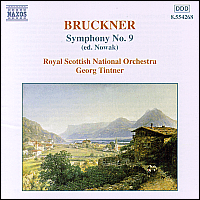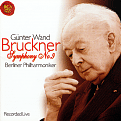


Towards the close of his life, Bruckner found a certain measure of recognition and appreciation. In 1891, Bruckner received an Honorary Doctorate from University of Vienna, and a few years later, the Emperor presented him with a stipend and a decoration. His seventieth birthday was the occasion for a nationwide celebration. However, in spite of this increasing favor, Bruckner still had his hostile critics. And, after his death in 1896, his symphonies still continued to arouse controversy outside of German and Austria. The Ninth Symphony occupied Bruckner for the last nine years of his life. By 1894 he had completed the slow movement, but at his death in 1896 the finale remained too fragmentary to be convincingly completed. Brucknerites tend to rejoice that the Ninth was never finished, contending that the great Adagio is a farewell to life and that anything following it would be anticlimactic (I agree so). Nonetheless Bruckner wrestled with a finale for two years and finished the greater part of it in full score. But he was haunted by the fear that he would not have time to complete the symphony. The physician who attended him in his final illness once discovered him on his knees, praying "Dear God, let me get well soon. You see, I need my health to finish the Ninth." The symphony is indeed dedicated to "Dem lieben Gott"ó"God the beloved".

 Georg Tintner
Georg Tintner 


Georg Tintnerís Naxos account offers an exclusively successful reading, with every players doing their utmost to get things right. This is a performance of impressive breadth, dignity and power, with no suggestion of routine in a single bar. Tintnerís control of rhythm prevents any feeling of sluggishness or heaviness. The orchestra makes much of the first-movement climax and plays with considerable passion and impressive body of tone in the Scherzo, and there is an element of restraint in the Adagio, which prevents any feeling of hysteria. Tintnerís understanding of Brucknerís last masterpiece is full of hope and humanity, and he makes this recording a supreme achievement.

 Bruno Walter
Bruno Walter 


Bruno Walterís account of Brucknerís last symphony is usually considered as the first choice, but I have some different opinions. To be honest, it is a deeply concentrated reading, bringing out much unexpected details, with every phrase freshly turned in seamless spontaneity. Throughout, Bruno Walter has an unerring sense of purpose and direction and the momentum never slackens. There is no doubt that this is among the most vividly dramatic accounts of this symphony, but Walter doesnít capture Brucknerís spirituality of peace and disillusion in this work (Tintner achieved that precisely in his reading). I donít quite agree to keep it on the top of all the versions. And the early stereo recording, made in 1958, is no longer satisfying these days.

 Carlo Maria Giulini
Carlo Maria Giulini 


Giuliniís version of the Ninth Symphony with the Vienna Philharmonic combines deep sensitivity and great refinement, and the points of details as well as the overall warmth keep this version among the finest on record. Giuliniís warmly expressive phrasing never sounds self-conscious when it is regularly given the freshness of lyricism. The music consistently speaks in a true Brucknerian accent, culminating in the Adagio, registering a mood of tragedy and disillusion. The recording is also rich and firmly focused.

 GŁnter Wand
GŁnter Wand 


Wand conducts a powerful, warmly expressive performance which, thank in part to a live recording, carries conviction in its flexible spontaneity. He offers a strong, warm reading in which climaxes are thrust home powerfully, with full dramatic impact. The actual sounds of the Berlin Philharmonic, the brass as well as the ardent strings bring a plangent coloring to Brucknerís great scoring.

 Leonard Bernstein
Leonard Bernstein 


As a great Mahler conductor of our age, Bernstein seldom touches Bruckner. However, he seems to have a partiality with the composerís last symphony. This is the second time he records this work. This is a performance full of passion and brilliance, which show Bernsteinís special understanding to Bruckner. The weight of sound, which Bernstein draws from the Vienna Philharmonic in his fuller-bodied recording, goes with a rather more expressive style, so that unison string melodies, as in the Scherzo or throughout the Adagio, sound more obviously Mahlerian. Bernstein died a few months later after this live performance, and this is one of his last recordings.

Other Recommendations:
Herbert Von Karajan (1966)

